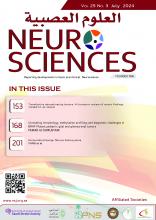Research ArticleOriginal Article
Open Access
Leveraging multivariate analysis and adjusted mutual information to improve stroke prediction and interpretability
Moutasem S. Aboonq and Saeed A. Alqahtani
Neurosciences Journal July 2024, 29 (3) 190-196; DOI: https://doi.org/10.17712/nsj.2024.3.20230100
Moutasem S. Aboonq
From the Department of Physiology, College of Medicine, Taibah University, Al-Madinah Al-Munawwarah, Kingdom of Saudi Arabia
MD, PhDSaeed A. Alqahtani
From the Department of Physiology, College of Medicine, Taibah University, Al-Madinah Al-Munawwarah, Kingdom of Saudi Arabia
MD, PhD
References
- 1.↵
- 2.↵Stroke Facts. National Center for Chronic Disease Prevention and Health Promotion; About the Division for Heart Disease and Stroke Prevention 2024. https://www.cdc.gov/stroke/data-research/facts-stats/index.html
- 3.↵
- 4.↵Stroke Risk Factors, Genetics, and Prevention | Circulation Research [Internet]. [cited 2022 Dec 29]. Available from: https://www.ahajournals.org/doi/10.1161/circresaha.116.308398
- 5.↵
- 6.↵
- Bukhari S,
- Yaghi S,
- Bashir Z
- 7.↵
- Delgardo M,
- Rabin G,
- Tudor T,
- Tang AJ,
- Reeves G,
- Connolly ES
- 8.↵
- Hong C,
- Pencina MJ,
- Wojdyla DM,
- Hall JL,
- Judd SE,
- Cary M, et al.
- 9.↵
- Nagar AK,
- Singh Jat D,
- Mishra DK,
- Joshi A
- Zafeiropoulos N,
- Mavrogiorgou A,
- Kleftakis S,
- Mavrogiorgos K,
- Kiourtis A,
- Kyriazis D
- 10.↵
- Khosravi B,
- Weston AD,
- Nugen F,
- Mickley JP,
- Kremers HM,
- Wyles CC, et al.
- 11.↵
- Chandrabhatla AS,
- Kuo EA,
- Sokolowski JD,
- Kellogg RT,
- Park M,
- Mastorakos P
- 12.
- Sheth SA,
- Giancardo L,
- Colasurdo M,
- Srinivasan VM,
- Niktabe A,
- Kan P
- 13.↵
- Daidone M,
- Ferrantelli S,
- Tuttolomondo A
- 14.↵CDC - 2021 BRFSS Survey Data and Documentation [Internet]. 2023 [cited 2023 Oct 1]. Available from: https://www.cdc.gov/brfss/annual_data/annual_2021.html
- 15.↵
- Reeves MJ,
- Bushnell CD,
- Howard G,
- Gargano JW,
- Duncan PW,
- Lynch G, et al.
- 16.↵
- 17.↵
- Shajahan S,
- Sun L,
- Harris K,
- Wang X,
- Sandset EC,
- Yu AY, et al.
- 18.↵
- Chen RL,
- Balami JS,
- Esiri MM,
- Chen LK,
- Buchan AM
- 19.
- 20.↵
- Popa-Wagner A,
- Petcu EB,
- Capitanescu B,
- Hermann DM,
- Radu E,
- Gresita A
- 21.↵
- Strazzullo P,
- D’Elia L,
- Cairella G,
- Garbagnati F,
- Cappuccio FP,
- Scalfi L
- 22.↵
- 23.↵
- 24.↵
- Ye J,
- Hu Y,
- Chen X,
- Yin Z,
- Yuan X,
- Huang L, et al.
- 25.↵
- Kasza KA,
- Tang Z,
- Xiao H,
- Marshall D,
- Stanton C,
- Gross A, et al.
- 26.↵
- Stanaway JD,
- Afshin A,
- Gakidou E,
- Lim SS,
- Abate D,
- Abate KH, et al.
- 27.↵
- Chiu N,
- Chiu L,
- Aggarwal R,
- Raber I,
- Bhatt DL,
- Mukamal KJ
- 28.Diabetes Statistics. DRIF. [cited 2023 Sep 29]. Available from: https://diabetesresearch.org/diabetes-statistics/
- 29.↵CDC. By the Numbers: Diabetes in America. Centers for Disease Control and Prevention. 2022 [cited 2023 Sep 29]. Available from: https://www.cdc.gov/diabetes/health-equity/diabetes-by-the-numbers.html
- 30.↵
- Bierbower E,
- Griffith N,
- Raman VK,
- Brar V,
- Roseman J,
- Deedwania P, et al.
- 31.↵
- Ho JSY,
- Sia CH,
- Zheng H,
- Tan BYQ,
- Ho AFW,
- Yeo LLL, et al.
- 32.↵
- Wajngarten M,
- Silva GS
- 33.↵
- Fishman B,
- Bardugo A,
- Zloof Y,
- Bendor CD,
- Libruder C,
- Zucker I, et al.
- 34.↵
- Charmilisri A,
- Harshi I,
- Madhushalini V,
- Raja L
- 35.↵
- Kaur M,
- Sakhare SR,
- Wanjale K,
- Akter F
- 36.
- Alanazi EM,
- Abdou A,
- Luo J
- 37.↵
- 38.↵
- 39.
- Lee J,
- Park KM,
- Park S
- 40.↵
In this issue
Leveraging multivariate analysis and adjusted mutual information to improve stroke prediction and interpretability
Moutasem S. Aboonq, Saeed A. Alqahtani
Neurosciences Journal Jul 2024, 29 (3) 190-196; DOI: 10.17712/nsj.2024.3.20230100
Jump to section
Related Articles
- No related articles found.
Cited By...
- No citing articles found.





